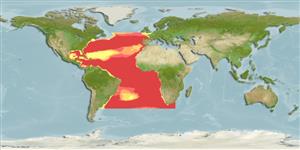Common names from other countries
>
Myctophiformes (Lanternfishes) >
Myctophidae (Lanternfishes) > Diaphinae
Etymology: Diaphus: Greek, dis, dia = through + Greek, physa, phyo = to beget, to have as offspring (Ref. 45335).
More on author: Bleeker.
Environment: milieu / climate zone / depth range / distribution range
Ecología
marino; oceanodromo (Ref. 51243); rango de profundidad 0 - 805 m (Ref. 13608), usually 450 - 500 m (Ref. 4775). Subtropical; 51°N - 40°S
Eastern Atlantic: Canary Islands (Ref. 6808), 20°N (inshore from 29°N) to about 10°S west of 0°, with disjunct distribution between 14°N and 8°N, but to 23°S east of 0°. Isolates north to off south-west Ireland (Ref. 4775). Western Atlantic: tropical areas but with expatriate extensions to 51°N and 45°S in western boundary currents [(apparently absent over a minimum region off Brazil) according to Ref. 4479 or 4775] (Ref. 4479, 4775). Very rare or absent in the Indo-Pacific.
Tropical Indian and Atlantic; east coast of South America (Ref. 47377).
Length at first maturity / Tamaño / Peso / Age
Maturity: Lm 5.2 range ? - ? cm
Max length : 9.5 cm TL macho / no sexado; (Ref. 40727); edad máxima reportada: 1.00 años (Ref. 4882)
Short description
Claves de identificación | Morfología | Morfometría
Espinas dorsales (total) : 0; Radios blandos dorsales (total) : 14 - 15; Espinas anales: 0; Radios blandos anales: 14 - 15.
High-oceanic and mesopelagic populations are found between 225-750 m during the day (maximum abundance at 450-500 m) and is nyctoepipelagic at surface down to 125 m at night (Ref. 4479). Pseudoceanic and pelagic populations are found in the upper 50 m at night (Ref. 4066). Feeding is acyclic in northwest Africa (Ref. 9198).
Life cycle and mating behavior
Maturities | Reproducción | Spawnings | Egg(s) | Fecundities | Larva
Hulley, P.A., 1990. Myctophidae. p. 398-467. In J.C. Quero, J.C. Hureau, C. Karrer, A. Post and L. Saldanha (eds.) Check-list of the fishes of the eastern tropical Atlantic (CLOFETA). JNICT, Lisbon; SEI; Paris; and UNESCO, Paris. Vol. 1. (Ref. 4479)
IUCN Red List Status (Ref. 130435)
CITES (Ref. 128078)
Not Evaluated
Threat to humans
Harmless
Human uses
Herramientas
Special reports
Download XML
Fuentes de Internet
Estimates based on models
Preferred temperature (Ref.
115969): 6.5 - 13.9, mean 9.6 (based on 46 cells).
Phylogenetic diversity index (Ref.
82804): PD
50 = 0.5000 [Uniqueness, from 0.5 = low to 2.0 = high].
Bayesian length-weight: a=0.00741 (0.00455 - 0.01207), b=3.00 (2.86 - 3.14), in cm Total Length, based on LWR estimates for this species & Genus-body shape (Ref.
93245).
Nivel trófico (Ref.
69278): 3.0 ±0.00 se; based on food items.
Resiliencia (Ref.
120179): Alto, población duplicada en un tiempo mínimo inferior a 15 meses (K=1.83-3.81; tm=0.7; tmax=1.2).
Fishing Vulnerability (Ref.
59153): Low vulnerability (10 of 100).
